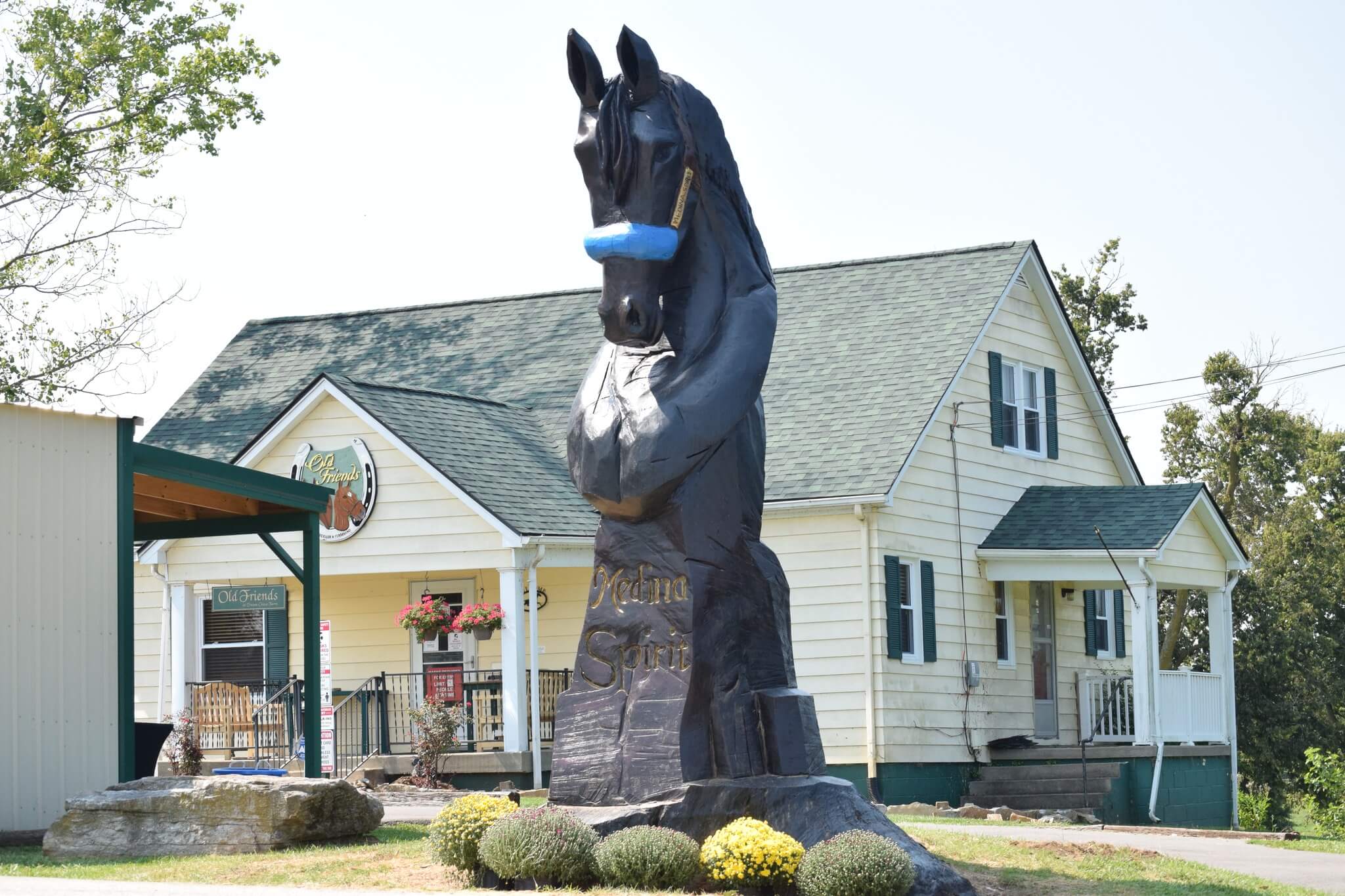
A Culture Of Sculpture
Written by Kathy Witt
Sergeant Reckless. The Cerebral Dancer. The Bride Stripped Bare by Her Bachelors.
Sculptural art abounds in Georgetown—from graceful, calming elements in Yuko-en on the Elkhorn to pieces highlighting the beauty and elegance of horses to contemporary works that spark curiosity and underscore the importance of visual arts . . . each one a meaning, a message, a memorial—all magnificent works that enhance the aesthetic beauty of the environments within which they are set.
 At Old Friends Thoroughbred Retirement Farm, beloved racing legend, Medina Spirit—who died in 2021 during a track workout—is remembered in a moving tribute carved by Kenya artist Kiptoo Tarus. Known for his large-scale wood sculptures, Tarus sculpted the likeness of the dark bay colt from a century-old Sycamore tree that had died on the grounds of the aftercare facility. founder Michael Blowen described the sculpture of the dark bay colt as “kind of like the Old Friends’ Mount Rushmore” during its unveiling.
At Old Friends Thoroughbred Retirement Farm, beloved racing legend, Medina Spirit—who died in 2021 during a track workout—is remembered in a moving tribute carved by Kenya artist Kiptoo Tarus. Known for his large-scale wood sculptures, Tarus sculpted the likeness of the dark bay colt from a century-old Sycamore tree that had died on the grounds of the aftercare facility. founder Michael Blowen described the sculpture of the dark bay colt as “kind of like the Old Friends’ Mount Rushmore” during its unveiling.
Medina Spirit finished first in the 2021 Kentucky Derby (but was later disqualified due to a drug violation), came in second in that year’s Breeders’ Cup Classic and third in the Preakness Stakes. He was laid to rest at Old Friends, alongside Kentucky Deby winners Charismatic and War Emblem.
More famous horses are celebrated in statuary at Kentucky Horse Park. Sergeant Reckless, a bronze created by Jocelyn Russell, recalls the Mongolian mare who braved the front lines with her fellow U.S. Marines during the Korean War. Reckless rose to the rank of Staff Sergeant and was awarded two Purple Hearts for her service. She died in 1968 and was buried with full military honors.
The Man ‘O War statue, sculpted in bronze by Herbert Haseltine, remembers the chestnut horse with a white star and stripe on his forehead, who is considered the greatest thoroughbred of the 20th century. Man o’ War won 20 of 21 races—his only loss coming at the hands of a horse named, curiously enough, Upset.
Secretariat, also regarded as one of the great racehorses of all time, is captured in bronze not once, but twice at Kentucky Horse Park. Both pieces—one by Edwin Bogucki and one by Jim Reno—capture the spirit of Big Red, who in 1973 became the first Triple Crown winner in 25 years.
The three equestrian sculptures are among nearly 20 that may be seen at the park.
Among the collection of sculptures at Georgetown College are a memorial anchored by a weeping cherry tree, “In Memory of the Lives Lost on September 11, 2001;” a tribute to the friend of the Tiger Bands, “Mr. Georgetown Tiger;” and the reflective piece, “The Bride Stripped Bare by Her Bachelors.”
The sculptures are scattered about the grounds of the college, collectively providing visual vibrancy to the campus and an opportunity for students and visitors to learn about art. The outdoor setting is an ideal gallery space for the variously sized works, created in bronze, limestone, granite and other materials.
As described in Chair of Georgetown College Art Department Dr. Juilee Decker’s comments, “This collection of sculpture activates the campus by offering contemporary perspectives that supplement the history of the campus since the founding of the College in 1829.”
Download the Georgetown College Public Sculpture Brochure.pdf to learn more about each piece in the collection.
At Yuko-en on the Elkhorn, the Official Kentucky-Japan Friendship Garden, the sculptural elements are harmoniously integrated into the landscape of this four-season, five-acre garden, where native plants and Japanese garden principles create a calming oasis for contemplation and meditation.
“The sculptures enhance the quiet—Zen—effect of the garden,” said Judy Littleton, event manager. “And the garden gives visitors a quiet place to walk and reflect.”
A self-guided tour brings visitors through the Tokugawa Gates, built by local craftsmen, carpenters and metal workers and intended to mark the place where worldly stresses are left behind; to Mark Wallis’ playful metal sculpture, the Cerebral Dancer; and to Judy’s own favorite, the Shizedourou lantern, located near the Upper Waterfall and Mountain.
“To me, it is the most organic of the sculptures, providing that calm, quiet feel the garden strives to give,” she said.
Spring, summer and fall are ideal seasons to explore the sculptures at each of these Georgetown landmarks. The sculptures can be part of a self-guided tour during visits to Yuko-en, Georgetown College and Kentucky Horse Park and, in the case of Old Friends, as part of a guided tour. Visit individual websites for more information.
Author: Kathy Witt
Kathryn Witt is an award-winning travel and lifestyle writer, syndicated columnist and author of several books, including Secret Cincinnati, The Secret of the Belles and Atlanta Georgia: A Photographic Portrait. A member of SATW, Authors Guild and the Society of Children’s Books & Illustrators, she lives in northern Kentucky.

